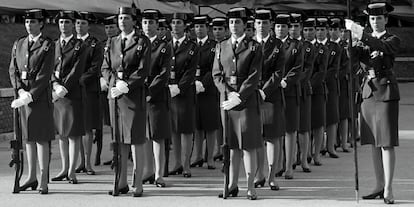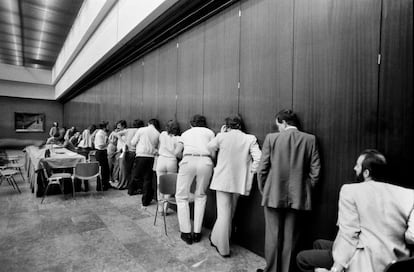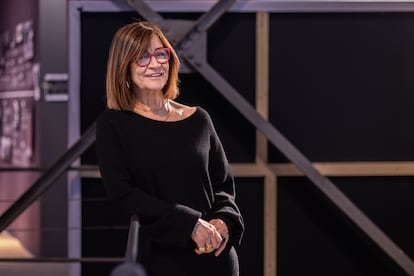Marisa Flórez, photographer: “A morbid image demeans the person portrayed and the person who takes it.”

The arrival of Guernica in Spain in September 1981 ; the first pro-abortion demonstrations, the post-Franco Congress of Deputies, during the Transition... Photographer Marisa Flórez (León, 1948) has captured a historic period in the country due to its social and political fervor, and this excitement is conveyed in the exhibition A Time to Look (1970-2020) , at the Canal de Isabel II Hall in Madrid, which opens this Tuesday and can be seen until July 20. Organized by the Ministry of Culture of the Community of Madrid and included in the PHotoEspaña festival , the exhibition is curated by Mónica Carabias Álvaro and brings together 185 images in a montage that combines various media: photographic paper, light boxes... Flórez was awarded the National Prize for Graphic Journalism (1981) and the prestigious Piedad Isla Photography Prize (2015).
Question: What can be seen in the exhibition?
Answer: Some people will reminisce about past moments when they come; they'll see how Spanish society has changed, but without nostalgia, and others will discover a new world because they weren't even born yet. These are facts from a journalistic perspective, plus the personalities who were there.
Q. At what point did you think you could make a living from photography?
A. Honestly, I never thought I'd make a living from this. I've loved photography ever since I was little, and then I had the opportunity to start taking photos and showing them, and people telling me they liked them. I've worked with professional photographers who were passionate about it, and I learned from them. And then you learn the technique.
Q. What were you looking for when you took photos?
A. At that moment, faced with something happening, you don't really think about it, but I've always been clear that I had to try to do something different because otherwise, the next day the reader would see the same thing in the press. Escape from officialdom, have a personal perspective. And, of course, since journalism is what I've done most, the news had to be there. If you then add great lighting and it creates beauty...

P. In photojournalism it's 'I catch you here, I kill you here.'
A. Of course, if you don't take a moment, it won't come back; there's no Moviola. It's about being in the right place, being lucky, and knowing what you want to do.
Q. When you started, press photography was almost entirely done by men.
A. There were only a few women reporting, but I've never had any problems working with colleagues. I've had the same problems as any professional. It's true that I've encountered problematic situations, for example, in official positions, but that's because we came from a sexist society that didn't see women in those places. I've also been lucky enough to work at EL PAÍS , a media outlet that has always supported me. Once, with an actor, I went to take a photo, and he said, "Not now." I went to the newspaper, and a while later they called me. "Sorry, I'll go wherever you want," he said.
Q. What has changed most in newspaper photography in the half-century covered by your exhibition?
A. There used to be more money, and since that's not the case today, with the big agencies you can have the same photos in every newspaper. As a photo editor, I always said, "We'll give you the best photo." Even if we had sent a photographer, if the best one came from an agency, then it would be given. It wasn't a question of who signed the photo, but rather that the reader received the best photo. You always have to ensure quality, but that costs a lot of money. And on a technical level, today everything that happens happens almost in real time.
Q. How did you approach portraits?
A. I listened to the interview to get to know the person, to see how they spoke, how they reacted to questions, how they moved their hands. Although I usually had little time, I was interested in going further, but that requires preparation. I served three terms in Congress and knew every day the topics that would be discussed and which characters would be involved. It wasn't like just passing by and seeing if the Holy Spirit would come.
Q. Which characters were the most seductive?
A. I'm not much of a mythomaniac, but some were impressive, like Luis Buñuel , who was secretive with the press. Pasionaria [Dolores Ibárruri] was a woman who had the power of myth, already older, dressed in black, with that hair... It's a profession that allows you to observe what's happening up close and meet such interesting people.

P. And there would be those who were horrified by posing.
R. Yes, but we had to try to make them feel comfortable, that's also part of the character, their shyness.
Q. Regarding the relationship between photographers and politicians, when did Peru go to hell?
A. I always kept my distance, even though we spent hours and hours together, knowing where the person was and where you were. It was a time when we were all learning: politicians to conduct politics in a new way, and the press to report things in a different, more relatable way. Politics was conducted in Parliament and also outside, for example, in secret meetings in restaurants.

Q. What was the most difficult thing about taking photos on the street during the Transition?
A. The attacks. There were years when you could encounter up to three in a week. You had to photograph the attack, the families... it was tremendous, a very tough time.
Q. Did you consider not taking any photos on those occasions because they were too unpleasant?
R. I did everything I could. Then you could see an image and say, "This shouldn't be published." You shouldn't report with morbidity, but with truthful information. Morbidity demeans the person being portrayed and the person taking the photo.
EL PAÍS


%3Aformat(jpg)%3Aquality(99)%3Awatermark(f.elconfidencial.com%2Ffile%2Fbae%2Feea%2Ffde%2Fbaeeeafde1b3229287b0c008f7602058.png%2C0%2C275%2C1)%2Ff.elconfidencial.com%2Foriginal%2Fc3c%2F6ba%2Fcef%2Fc3c6bacef1fb0313ab3c7f3351187c7c.jpg&w=3840&q=100)

%3Aformat(jpg)%3Aquality(99)%3Awatermark(f.elconfidencial.com%2Ffile%2Fbae%2Feea%2Ffde%2Fbaeeeafde1b3229287b0c008f7602058.png%2C0%2C275%2C1)%2Ff.elconfidencial.com%2Foriginal%2F725%2Fcd5%2F909%2F725cd59091df8c70aeb06deadfb98e05.jpg&w=3840&q=100)
